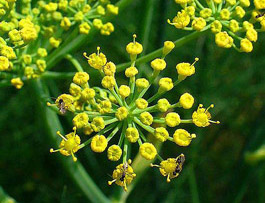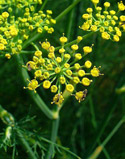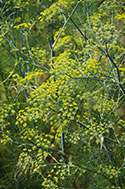Common Fennel
Foeniculum vulgare • Class B |
||
| Family Name: | Apiaceae family (ay-pee-AY-see-ee) | |
| Common: | Carrot/celery family (formerly Umbelliferae) | |
| Genus: |
Foeniculum (fen-IK-yoo-lum) Meaning: Diminutive form of Latin foenum, hay; referring to the smell |
|
| Species: |
vulgare (vul-GAIR-ee) Meaning: Common |
|
Description:
This licorice scented Mediterranean herb grows 4 to 10 feet tall. It has feathery, dark green to bronze colored leaves and umbrella shaped clusters of yellow flowers.
Bloomtime is from May to September.
Foliage, stem, roots and seeds are hairless and all have a very strong licorice scent.
Why Is it a Noxious Weed?
Common fennel forms dense infestations, out compete native plants, and reduces native wildlife habitat. Once established it is difficult to control, due to its strong competitive abilities and persistent seed bank.
Where Does it Grow?
It is found in disturbed sites such as roadsides, embankments, and vacant lots. It also easily colonizes grasslands and along waterways, wetlands, and streams.
Facts:
Common fennel infestations are becoming more common in Pierce county.
Mature fennel plants are difficult to remove due to the large tap roots which can reach depths of up to 10 feet. The plant can reestablish itself from small pieces of roots or bulbs. Bulbing fennel, (also known as Florence fennel, F. vulgare azoricum) does not pose a threat and is not an invasive problem, or listed as a noxious weed in Washington state.
It reproduces by seed and vegetative root buds. A single plant can produce thousands of seeds during its 1st year of growth and more than 100,000 in subsequent years.
Control Options:
- When growing fennel, purchase only non-invasive, annual varieties of fennel. Also, be very careful when removing plants that have mature seed. Clip and bag the seed heads before you cut the plants, otherwise, you may accidently make the problem worse by spreading seeds into other areas. Fennel germinates rapidly if the plants were allowed to seed in past seasons.
- Small seedlings can be hand pulled when soil is soft or loose. Mature fennel plants are difficult to remove due to the long taproots. If the root breaks, remove the upper 3 to 6 inches. Cutting the root before the plant sets seeds reduces the number of re-sprouts. Cutting will not control common fennel unless it is done numerous times throughout the growing season prior to seed set and for at least 4 successive seasons. Mowing too early encourages numerous sprouts as well.
- Spot applications of herbicides containing glyphosate (as in Roundup Pro) can be effective in controlling common fennel. Apply when plants are actively growing and before they develop blooming stalks, usually before June.
- To minimize any harmful impact on bees and other pollinators, timing is important. Ideally, treat plants before blooming. If treatment after blooming is necessary, do control work early in the morning, or in the evening when bees are less active.
More Information:
For more information on this noxious weed Download our Flyer or visit Washington State Noxious Weed Control Board Here. Photos by Rebecca Shoemaker, Pierce County Noxious Weed Control Board.
More Pictures:






 Pierce County Noxious Weed Control Board • 9200 122nd St E, Puyallup, WA 98373 • 253-798-7263
Pierce County Noxious Weed Control Board • 9200 122nd St E, Puyallup, WA 98373 • 253-798-7263